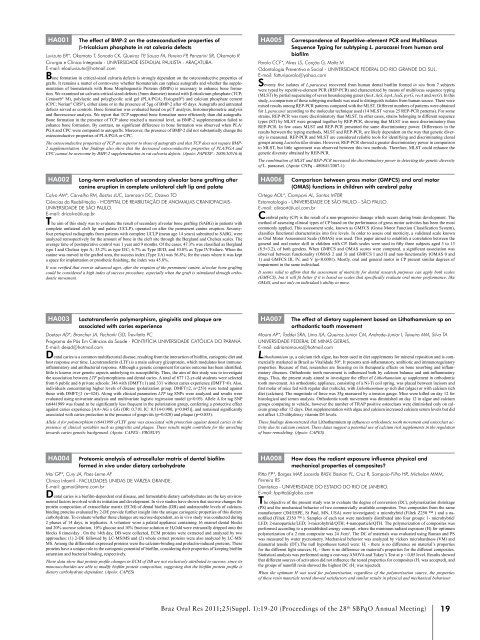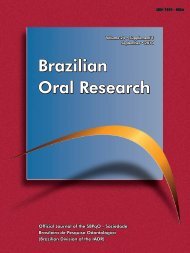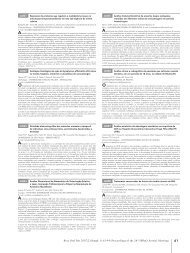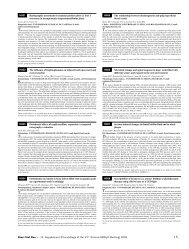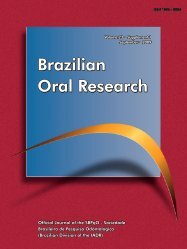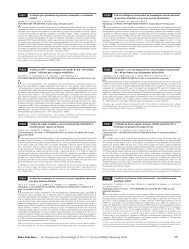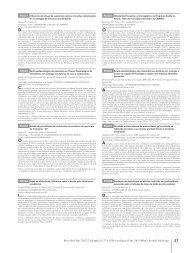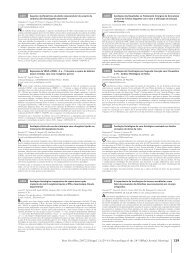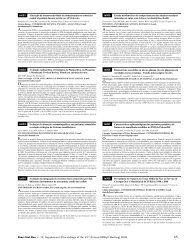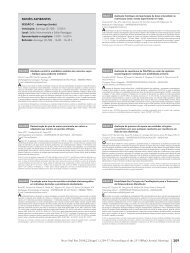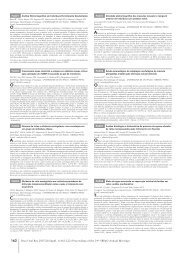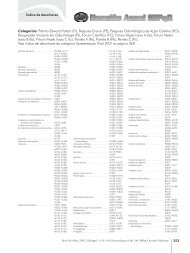Brazilian Oral Research - Sociedade Brasileira de Pesquisa ...
Brazilian Oral Research - Sociedade Brasileira de Pesquisa ...
Brazilian Oral Research - Sociedade Brasileira de Pesquisa ...
Create successful ePaper yourself
Turn your PDF publications into a flip-book with our unique Google optimized e-Paper software.
HA001<br />
The effect of BMP-2 on the osteoconductive properties of<br />
β-tricalcium phosphate in rat calvaria <strong>de</strong>fects<br />
Luvizuto ER*, Okamoto T, Sonoda CK, Queiroz TP, Souza FA, Pereira FP, Panzarini SR, Okamoto R<br />
Cirurgia e Clínica Integrada - UNIVERSIDADE ESTADUAL PAULISTA - ARAÇATUBA.<br />
E-mail: eloaluvizuto@hotmail.com<br />
Bone formation in critical-sized calvaria <strong>de</strong>fects is strongly <strong>de</strong>pen<strong>de</strong>nt on the osteoconductive properties of<br />
grafts. It remains a matter of controversy whether biomaterials can replace autografts and whether the supplementation<br />
of biomaterials with Bone Morphogenetic Proteins (BMPs) is necessary to enhance bone formation.<br />
We examined rat calvaria critical-sized <strong>de</strong>fects (5mm diameter) treated with β-tricalcium phosphate (TCP;<br />
Cerasorb ® M), polylactic and polyglycolic acid gel (PLA/PGA; Fisiograft ® ) and calcium phosphate cement<br />
(CPC; Norian ® CRS ® ), either alone or in the presence of 5μg of BMP-2 after 45 days. Autografts and untreated<br />
<strong>de</strong>fects served as controls. Bone formation was evaluated based on μCT analysis, histomorphometric analysis<br />
and fluorescence analysis. We report that TCP supported bone formation more efficiently than did autografts.<br />
Bone formation in the presence of TCP alone reached a maximal level, as BMP-2 supplementation failed to<br />
enhance bone formation. By contrast, no significant difference in bone formation was observed when PLA/<br />
PGA and CPC were compared to autografts. Moreover, the presence of BMP-2 did not substantially change the<br />
osteoconductive properties of PLA/PGA or CPC.<br />
The osteoconductive properties of TCP are superior to those of autografts and that TCP does not require BMP-<br />
2 supplementation. Our findings also show that the <strong>de</strong>creased osteoconductive properties of PLA/PGA and<br />
CPC cannot be overcome by BMP-2 supplementation in rat calvaria <strong>de</strong>fects. (Apoio: FAPESP - 2008/10516-6)<br />
HA002 Long-term evaluation of secondary alveolar bone grafting after<br />
canine eruption in complete unilateral cleft lip and palate<br />
Calvo AM*, Carvalho RM, Bastos JUC, Lorenzoni DC, Ozawa TO<br />
Ciências da Reabilitação - HOSPITAL DE REABILITAÇÃO DE ANOMALIAS CRANIOFACIAIS-<br />
UNIVERSIDADE DE SÃO PAULO.<br />
E-mail: dricalvo@usp.br<br />
The aim of this study was to evaluate the result of secondary alveolar bone grafting (SABG) in patients with<br />
complete unilateral cleft lip and palate (UCLP), operated on after the permanent canine eruption. Seventyfour<br />
periapical radiographs from patients with complete UCLP (mean age 14 years) submitted to SABG, were<br />
analyzed retrospectively for the amount of bone in the cleft site through the Bergland and Chelsea scales. The<br />
average time of postoperative control was 1 year and 9 months. Of the cases, 47.3% was classified as Bergland<br />
type I and Chelsea type A; 35.2% as type II/C; 6.7% as Type III/D, and 10.8% as Type IV/Failure. When the<br />
canine was moved in the grafted area, the success in<strong>de</strong>x (Type I/A) was 56.8%; for the cases where it was kept<br />
a space for implantation or prosthetic finishing, the in<strong>de</strong>x was 45.8%.<br />
It was verified that even in advanced ages, after the eruption of the permanent canine, alveolar bone grafting<br />
could be consi<strong>de</strong>red a high in<strong>de</strong>x of success procedure, especially when the graft is stimulated through orthodontic<br />
movement.<br />
HA005 Correspon<strong>de</strong>nce of Repetitive-element PCR and Multilocus<br />
Sequence Typing for subtyping L. paracasei from human oral<br />
biofilm<br />
Parolo CCF*, Alves LS, Corção G, Maltz M<br />
Odontologia Preventiva e Social - UNIVERSIDADE FEDERAL DO RIO GRANDE DO SUL.<br />
E-mail: fatturiparolo@yahoo.com<br />
Seventy five isolates of L.paracasei recovered from human <strong>de</strong>ntal biofilm formed in situ from 7 subjects<br />
were typed by repetitive-element PCR (REP-PCR) and characterized by means of multilocus sequence typing<br />
(MLST) by partial sequencing of seven housekeeping genes (fusA, ileS, lepA, leuS, pyrG, recA and recG). In this<br />
study, a comparison of these subtyping methods was used to distinguish isolates from human source. There were<br />
mixed results among REP-PCR patterns compared with the MLST. Different numbers of patterns were obtained<br />
for L.paracasei according to the molecular technique used (14 MLST versus 25 REP-PCR patterns). For some<br />
strains, REP-PCR was more discriminatory than MLST. In other cases, strains belonging to different sequence<br />
types (ST) by MLST were grouped together by REP-PCR, showing that MLST was more discriminatory than<br />
REP-PCR. In few cases MLST and REP-PCR presented the same discriminatory power. Differences in the<br />
results between the typing methods, MLST and REP-PCR, are likely <strong>de</strong>pen<strong>de</strong>nt on the way that genetic diversity<br />
is measured. REP-PCR and MLST are consi<strong>de</strong>red reliable tools for i<strong>de</strong>ntifying and discriminating clonal<br />
groups among Lactobacillus strains. However, REP-PCR showed a greater discriminatory power in comparison<br />
to MLST, but little agreement was observed between this two methods. Therefore, MLST could enhance the<br />
genetic diversity obtained by REP-PCR.<br />
The combination of MLST and REP-PCR increased the discriminatory power in <strong>de</strong>tecting the genetic diversity<br />
of L. paracasei. (Apoio: CNPq - 480841/2007-1)<br />
HA006 Comparison between gross motor (GMFCS) and oral motor<br />
(OMAS) functions in children with cerebral palsy<br />
Ortega AOL*, Ciamponi AL, Santos MTBR<br />
Estomatologia - UNIVERSIDADE DE SÃO PAULO - SÃO PAULO.<br />
E-mail: aliraort@uol.com.br<br />
Cerebral palsy (CP) is the result of a non-progressive damage which occurs during brain <strong>de</strong>velopment. The<br />
method of assessing clinical types of CP based on the performance of gross motor activities has been the most<br />
commonly applied. This assessment scale, known as GMFCS (Gross Motor Function Classification System),<br />
classifies functional characteristics into five levels. In or<strong>de</strong>r to assess oral motricity, a validated scale known<br />
as <strong>Oral</strong> Motor Assessment Scale (OMAS) was used. This paper aimed to establish a correlation between the<br />
general and oral motor skill in children with CP. Both scales were used in fifty three subjects aged 3 to 13<br />
(8.5±3.2), of both gen<strong>de</strong>rs. When GMFCS and OMAS scores were compared, a significant association was<br />
observed between functionality (OMAS 2 and 3) and GMFCS I and II and non-functionality (OMAS 0 and<br />
1) and GMFCS III, IV, and V (p


